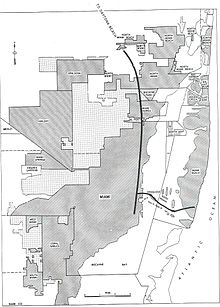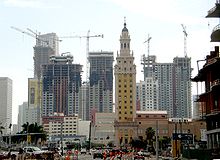- History of Miami
-
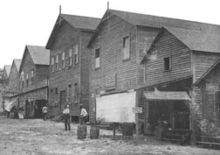 In 1896, close to 400 people crowded onto the second floor of the Lobby Pool Room to vote to incorporate Miami as a city. The building to the left in this photo is the site of this historic meeting.[1]
In 1896, close to 400 people crowded onto the second floor of the Lobby Pool Room to vote to incorporate Miami as a city. The building to the left in this photo is the site of this historic meeting.[1]
The area in which the city of Miami, Florida would later be founded by Europeans was inhabited for more than a thousand years by the Tequestas. Pedro Menéndez de Avilés and his men first visited and claimed the area around Miami for Spain in 1566. A Spanish mission was established one year later. Fort Dallas was built in 1836 and functioned as a military base during the Second Seminole War.[2]
The Miami area was better known as “Biscayne Bay Country” in the early years of its growth. The few published accounts from that period describe the area as a wilderness that held much promise.[3] The area was also characterized as “one of the finest building sites in Florida.”[3] However, the Great Freeze of 1894 changed all that, and the crops of the Miami area were the only ones in Florida that survived. Julia Tuttle, a local citrus grower, convinced Henry Flagler, a railroad tycoon, to expand his Florida East Coast Railroad to Miami. On July 28, 1896, Miami was officially incorporated as a city with a population of just over 300.[4]
Miami prospered during the 1920s but weakened after the collapse of the Florida land boom of the 1920s, the 1926 Miami Hurricane and the Great Depression in the 1930s. When World War II began, Miami, well-situated due to its location on the southern coast of Florida, played an important role in the battle against German submarines. The war helped to expand Miami's population to almost half a million. After Fidel Castro rose to power in 1959, many Cubans emigrated to Miami, further increasing the population. In the 1980s and 1990s, various crises struck South Florida, among them the Arthur McDuffie beating and the subsequent riot, drug wars, Hurricane Andrew, and the Elián González uproar. Miami remains a major international financial and cultural center.
Contents
Early settlement
The earliest evidence of Native American settlement in the Miami region came from about 10,000 years ago.[5] The region was filled with pine and hardwood forests and was home to plenty of deer, bear and wild fowl. The first inhabitants settled on the banks of the Miami River. The main villages were on the northern banks of the river. The early Native Americans created a variety of weapons and tools from shells.[6]
The inhabitants of the Miami area when the first Europeans visited were the Tequesta people, who controlled an area covering much of southeastern Florida, including what is now Miami-Dade County, Broward County, and the southern parts of Palm Beach County. The Tequesta Indians fished, hunted, and gathered the fruit and roots of plants for food, but did not practice any form of agriculture. They buried the small bones of the deceased, but put the larger bones in a box for the village people to see. The Tequesta are credited with making the Miami Circle.
1500s to 1700s: Early Spanish settlement
In 1513, Juan Ponce de León was the first European man to see the Miami area by sailing into Biscayne Bay. He wrote in his journal that he reached Chequescha, which was Miami's first recorded name.[7] It is unknown whether or not he came ashore and made contact with the natives. Pedro Menéndez de Avilés and his men made the first recorded landing when they visited the Tequesta settlement in 1566 while looking for Avilés' missing son, who was shipwrecked a year earlier.[8] Spanish soldiers led by Father Francisco Villareal built a Jesuit mission at the mouth of the Miami River a year later but it was short-lived. By 1570, the Jesuits decided to look for more willing subjects outside of Florida. After the Spaniards left, the Tequesta Indians were left to fend themselves from European-introduced diseases like smallpox. Wars with other tribes greatly weakened their population, and they were easily defeated by the Creek Indians in battles. By 1711, the Tequesta sent a couple of local chiefs to Havana, Cuba to ask if they could migrate there. The Cubans sent two ships to help them, but Spanish illnesses struck and most of the Indians died.[9] The Spaniards sent another mission to Biscayne Bay in 1743, where they built a fort and church. The missionary priests proposed a permanent settlement, where the Spanish settlers would raise food for the soldiers and American Indians. However, the proposal was rejected as impractical and the mission was withdrawn before the end of the year.[10]
1700s to 1800s: Early non-Spanish settlement
Samuel Touchett received a land grant from the British government of 20,000 acres (81 km2) in the Miami area in 1766. The grant was surveyed by Bernard Romans in 1772. A condition for making the grant permanent was that at least one white settler had to live on the grant for every 100 acres (0.4 km2) of land. While Touchett wanted to place a plantation on the grant, he was having financial problems and never was able to develop it.[11]
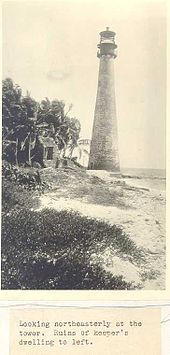 Cape Florida Lighthouse, the oldest-standing structure in Miami, built in 1825
Cape Florida Lighthouse, the oldest-standing structure in Miami, built in 1825
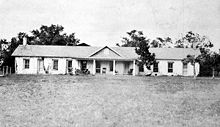 Fort Dallas, built in 1836
Fort Dallas, built in 1836
The first permanent white settlers in the Miami area arrived in the early 19th century. Pedro Fornells, a Minorcan survivor of the New Smyrna colony, moved to Key Biscayne to meet the terms of his Royal Grant for the island. Although he returned with his family to St. Augustine after six months, he left a caretaker behind on the island. On a trip to the island in 1803, Fornells had noted the presence of squatters on the mainland across Biscayne Bay from the island. In 1825 U.S. Marshal Waters Smith visited the Cape Florida Settlement (which was on the mainland) and conferred with squatters who wanted to obtain title to the land they were occupying.[12]
People came from the Bahamas and the Keys to South Florida to hunt for treasure from the ships that ran aground on the treacherous Great Florida reef. Some accepted Spanish land offers along the Miami River. At about the same time, the Seminole Indians arrived along with a group of runaway slaves. In 1825, the Cape Florida Lighthouse was built on nearby Key Biscayne to warn passing ships of the dangerous reefs.
In the 1830s, Richard Fitzpatrick bought land on the Miami River from the Bahamians, becoming one of the first and most successful of the permanent white settlers. He operated a successful plantation with slave labor where he cultivated sugarcane, bananas, maize, and tropical fruit. Fort Dallas was located on Fitzpatrick’s plantation on the north bank of the river.
The area was affected by the Second Seminole War, where Major William S. Harney led several raids against the Indians. Most non-Indian residents were soldiers stationed at Fort Dallas. It was the most devastating Indian war in American history, causing almost a total loss of population in the Miami area. The Cape Florida lighthouse was burned by Seminoles in 1836 and was not repaired until 1846.
After the Second Seminole War ended in 1842, Fitzpatrick’s nephew, William English, re-established the plantation in Miami. He charted the "Village of Miami" on the south bank of the Miami River and sold several plots of land. The Miami River lent its name to the burgeoning town, extending an etymology that derives from the Mayaimi Indian tribe.[citation needed] In 1844, Miami became the county seat, and six years later a census reported that there were ninety-six residents living in the area.[13] The Third Seminole War (1855–58) was not as destructive as the second one. Even so, it slowed down the settlement of southeast Florida. At the end of the war, a few of the soldiers stayed. Some of the Seminoles remained in the Everglades. However, as late as the 1890s, only a handful of families made their homes in Miami. Many of the settlers were homesteaders, attracted to the area by offers of 160 acres (0.6 km2) of free land by the US federal government. Among the homesteaders was William Brickell, known as the Father of Miami, who came from Cleveland, Ohio in 1871. He held a trading post and post office at the mouth of the Miami River and bought some land there.
1890s: Fast growth and formation
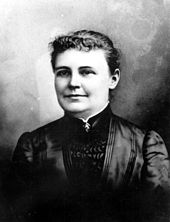 Julia Tuttle, the founder of Miami
Julia Tuttle, the founder of Miami
 The Barnacle Historic State Park, or the Barnacle, built in 1891, is the oldest house in its original location in Miami.
The Barnacle Historic State Park, or the Barnacle, built in 1891, is the oldest house in its original location in Miami.
In 1891, a wealthy Cleveland woman named Julia Tuttle purchased an enormous citrus plantation in the Miami area. Tuttle's husband, Frederick Tuttle, had died in 1886, and she decided to move to South Florida due to the "delicate health" of her children. She and William Brickell tried to get railroad magnate Henry Flagler to expand his rail line, the Florida East Coast Railroad, southward to the area, but he initially declined.
However, in the winter of 1894, Florida was struck by bad weather that destroyed virtually the entire citrus crop in the northern half of the state. A few months later on the night of February 7, 1895, Florida was hit by another freeze. That freeze wiped out the remaining crops and the new trees. Unlike the rest of the state, Miami was unaffected, and Tuttle's citrus became the only citrus on the market that year. Tuttle wrote to Flagler again, persuading him to visit the area and to see it for himself, and sent him some of the flowers to show that the area escaped the frost. Flagler did so, and concluded at the end of his first day that the area was ripe for expansion. He made the decision to extend his railroad to Miami and build a resort hotel.
On April 22, 1895, Flagler wrote to Tuttle a long letter recapping her offer of land to him in exchange for extending his railroad to Miami, laying out a city and building a hotel. The terms provided that Tuttle would award Flagler a 100-acre (0.4 km2) tract of land for the city to grow. Flagler wrote a similar letter to Brickell around that time.
While the railroad's extension to Miami remained unannounced in the spring of 1895, rumors of this possibility continued to multiply, fueling real estate activity in the Biscayne Bay area. The news of the railroad’s extension was officially announced on June 21, 1895. In late September, the work on the railroad began and settlers began pouring into the promised "freeze proof" lands. On October 24, 1895, the contract agreed upon by Flagler and Tuttle was approved.
With the railroad under construction, activity in Miami began to pick up. Men from throughout Florida flocked to Miami to await Flagler's call for workers of all qualifications to begin work on the promised hotel and city. By late December 1895, seventy-five of them already were at work clearing the site for the hotel. They lived mostly in tents and huts in the wilderness, which had no streets and few cleared paths. These men were primarily victims of the freeze, which had left both money and work scarce.
On February 1, 1896, Tuttle fulfilled the first part of her agreement with Flagler by signing two deeds to transfer land for his hotel and the 100 acres (0.4 km2) of land near the hotel site to him. The titles to the Brickell and Tuttle properties were based on early Spanish land grants and had to be determined to be clear of conflict before the marketing of the Miami lots began. On March 3, Flagler hired John Sewell from West Palm Beach to begin work on the town, while more people came into Miami. On April 7, 1896, the railroad tracks finally reached Miami, and the first train arrived on April 13. It was a special, unscheduled train, and Flagler was on board. The train returned to St. Augustine later that night. The first regularly scheduled train arrived on the night of April 15. The first week of train service provided only for freight trains, and passenger service did not begin until a week later, on April 22.
On July 28, 1896, the incorporation meeting to make Miami a city took place. The right to vote was restricted to all men who resided in Miami or Dade County. Joseph A. McDonald, Flagler’s chief of construction on the Royal Palm Hotel, was elected chairman of the meeting. After ensuring that the required number of voters was present, the motion was made to incorporate and organize a city government under the corporate name of "The City of Miami," with the boundaries as proposed. John B. Reilly, who headed Flagler's Fort Dallas land company, was the first elected mayor.
Initially, most residents wanted to name the city "Flagler". However, Henry Flagler was adamant that the new city would not be named after him. So on July 28, 1896, the City of Miami, named after the Miami River, was incorporated with 502 voters, including 100 registered black voters.[14] The blacks provided the primary labor force for the building of Miami. Clauses in land deeds confined blacks to the northwest section of Miami, which became known as "Colored Town" (today's Overtown).[15]
Twentieth century
1900s to 1930s: The Magic City
 University of Miami, founded in 1925.
University of Miami, founded in 1925.
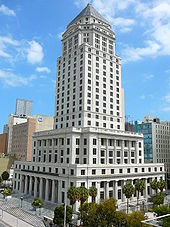 Dade County Courthouse, built in 1928, is the tallest building built in the 1920s.
Dade County Courthouse, built in 1928, is the tallest building built in the 1920s.
 The Miami River in 1935.
The Miami River in 1935.
Miami's growth up to World War II was astronomical. In 1900, 1,681 people lived in Miami, Florida; in 1910, there were 5,471 people; and in 1920, there were 29,549 people. As thousands of people moved to the area in the early 20th century, the need for more land quickly became apparent. Up until then, the Florida Everglades only extended to three miles (5 km) west of Biscayne Bay. Beginning in 1906, canals were made to remove some of the water from those lands. Miami Beach was developed in 1913 when a two-mile (3 km) wooden bridge built by John Collins was completed. During the early 1920s, the authorities of Miami allowed gambling and were very lax in regulating Prohibition, so thousands of people migrated from the northern United States to the Miami region. This caused the first Florida construction boom and many high-rise buildings were built: some early developments were razed after their initial construction to construct larger buildings. The population of Miami doubled from 1920 to 1923.[16] The nearby areas of Lemon City, Coconut Grove and Allapattah were annexed in the fall of 1925, creating the Greater Miami area.
This speculation boom started to falter because of building construction delays. The transport system was constantly overloaded with bulky building materials. On January 10, 1926 the Prinz Valdemar, an old Danish warship on its way to becoming a floating hotel, ran aground and blocked Miami Harbor for nearly a month.[17] Already overloaded, the three major railway companies soon declared an embargo on all incoming goods except food. The cost of living had skyrocketed and finding an affordable place to live was nearly impossible.[18] This economic bubble was already collapsing when the catastrophic Great Miami Hurricane in 1926 ended what was left of the boom. According to the Red Cross, there were 373 fatalities. Other estimates vary, since there were a large number of people listed as "missing". Between 25,000 and 50,000 people were left homeless in the Miami area. The Category 4 storm was the 12th most costly and 12th most deadly to strike the United States during the 20th century.[19] The Great Depression followed, in which more than sixteen thousand people in Miami became unemployed. A Civilian Conservation Corps camp was opened in the area.[20]
In the mid-1930s, the Art Deco district of Miami Beach was developed. On February 15, 1933, an assassination attempt was made on President-elect Franklin D. Roosevelt by Giuseppe Zangara, an Italian anarchist, while Roosevelt was giving a speech in Miami's Bayfront Park. Mayor Anton Cermak of Chicago, who was shaking hands with Roosevelt, was shot and died two weeks later. Four other people were wounded, but President-elect Roosevelt was not harmed. At his sentencing Zangara said, "I decide to kill him and make him suffer. I want to make it 50-50. Since my stomach hurt I want to make even with capitalists by kill the President. My stomach hurt long time."[21] Zangara was quickly tried for Cermak's murder and was executed by the electric chair on March 20, 1933 in Raiford, Florida.
1940s: World War II
 Pan Am's terminal at Dinner Key in 1944 during World War II
Pan Am's terminal at Dinner Key in 1944 during World War II
By the early 1940s, Miami was recovering from the Great Depression, but then World War II started. Many of the cities in Florida were heavily affected by the war and went into financial ruin, but Miami remained relatively unaffected. Early in the war, German U-boats attacked several American ships. Among the American ships was the Portero del Llano, which was attacked by a German submarine and sank within sight of Miami Beach in May 1942. To defend against those U-boats, Miami was placed in two military districts, the Eastern Defense Command and the Seventh Naval District, which was designed to defend against those attacks.
In February 1942, the Gulf Sea Frontier was established to help guard the waters around Florida, and by June of that year, more attacks forced military leaders in Washington D.C. to increase the numbers of ships and men of the army group. They also had moved the headquarters from Key West to the DuPont building in Miami, taking advantage of its location at the southeastern corner of the U.S. As the war against the U-boats grew stronger, more military bases sprang up in the Miami area. The U.S. Navy took control of Miami's docks and established air stations at the Opa-locka Airport and in Dinner Key. The Air Force also set up bases in the local airports in the Miami area.
Many military schools, supply, and communications facilities were established in the area. Rather than building large army bases to train the men needed to fight the war, the Army and Navy came to South Florida and took over hotels for barracks, movie theaters for classrooms, and local beaches and golf courses for training purposes. Eventually, over five hundred thousand enlisted men and fifty thousand officers trained in South Florida.[22] After the end of the war, many servicemen and women returned to Miami, pushing the population up to almost half a million by 1950.
1950s to 1970s
First Cuban wave
Following the 1959 revolution that unseated Fulgencio Batista and brought Fidel Castro to power, most Cubans who were living in Miami went back to Cuba. That soon changed, and many middle class and upper class Cubans moved to Florida en masse with few possessions. Some Miamians were upset about this, especially the African Americans, as Cuban workers were replacing them at jobs.[citation needed] The school system struggled to educate the thousands of Spanish-speaking Cuban children. Many of those Cubans later participated in the failed Bay of Pigs Invasion. Many Miamians, thinking that World War III (the Cold War) was looming ahead, left the city, while others started building bomb shelters and stocking up on food and bottled water. Many of Miami's Cuban refugees realized for the first time that it would be a long time before they would get back to Cuba.[23] In 1965 alone, 100,000 Cubans packed into the twice daily "freedom flights" from Havana to Miami. Most of the exiles settled into the Riverside neighborhood, which began to take on the new name of "Little Havana". This area emerged as a predominantly Spanish-speaking community, and Spanish speakers elsewhere in the city could conduct most of their daily business in their native tongue. By the end of the 1960s, more than four hundred thousand Cuban refugees were living in Miami-Dade County.[24]
In the 1960s and 1970s, the Attorney General's authority was used to grant parole, or special permission, to allow Cubans to enter the country. However, parole only allows an individual permission to enter the country, not to stay permanently. In the case of Cubans, the Cuban Adjustment Act of 1966 resolved this dilemma. The Act provides that the immigration status of any Cuban who arrived since 1959 and has been physically present in the United States for at least a year "may be adjusted by the Attorney General to that of an alien lawfully admitted for permanent residence" (green card holder). The individual must be admissible to the United States (i.e., not disqualified on criminal or other grounds).
Civil Rights Movement
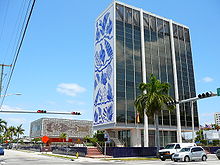 Miami Modern Architecture or MiMo, a style that originated in Miami in the 1950s as seen in the Bacardi Building in Midtown, built in 1963 and dedicated as a historic site in 2009.[25]
Miami Modern Architecture or MiMo, a style that originated in Miami in the 1950s as seen in the Bacardi Building in Midtown, built in 1963 and dedicated as a historic site in 2009.[25]
Although Miami was not really considered a major center of the Civil Rights movement of the 1950s and 1960s, it did not escape the change that occurred. Miami was a major city in the southern state of Florida, and had always had a substantial African-American and black Caribbean population.
In the 1970s, Miami was a news leader, resulting from response to a Dade County (now Miami-Dade) ordinance protecting individuals on the basis of sexual orientation.[citation needed] Opposition to this ordinance was led by Florida orange juice spokeswoman, Anita Bryant.
In December 1979, police officers pursued motorcyclist Arthur McDuffie in a high-speed chase after McDuffie made a provocative gesture towards a police officer. The officers claimed that the chase ended when McDuffie crashed his motorcycle and died. The coroner's report concluded otherwise. One of the officers testified that McDuffie fell off of his bike on an Interstate 95 on-ramp. When the police reached him he was injured but okay. The officers removed his helmet, beat him to death with their batons, put his helmet back on, and called an ambulance claiming there had been a motorcycle accident. Eula McDuffie, the victim's mother, said to the Miami Herald a few days later, "They beat my son like a dog. They beat him just because he was riding a motorcycle and because he was black."[26] A jury acquitted the officers after a brief deliberation.
After learning of the verdict of the McDuffie case, one of the worst riots in the history of the United States,[citation needed] the Liberty City Riots, broke out. By the time the rioting ceased three days later, over 850 people had been arrested, and at least 18 people had died. Property damage was estimated at around one hundred million dollars.[27] One more person, a sixty-five year old woman named Mildred Penton died after being in a coma for five weeks after being struck in the head with a brick.[citation needed]
In March 1980, the first black Dade County schools superintendent, Dr. Johnny L. Jones, had been convicted on grand theft charges linked to gold-plated plumbing. His conviction was overturned on appeal, and on July 3, 1986, the state attorney Janet Reno announced that Jones would not be retried on those charges. However, in a separate case, he was convicted on misdemeanor charges of soliciting perjury and witness tampering, and received a two-year jail sentence.[28]
1980s and 1990s
Later immigration
Later, the Mariel Boatlift of 1980 brought 150,000 Cubans to Miami, the largest in civilian history. Unlike the previous exodus of the 1960s, most of the Cuban refugees arriving were poor. During this time, many of the middle class non-Hispanic whites in the community left the city, often referred to as the "white flight." In 1960, Miami was 90% non-Hispanic white; by 1990, it was only about 10% non-Hispanic white.
In the 1980s, Miami started to see an increase in immigrants from other nations such as Haiti. As the Haitian population grew, the area known today as Little Haiti emerged, centered on Northeast Second Avenue and 54th Street. In 1985, Xavier Suarez was elected as Mayor of Miami, becoming the first Cuban mayor of a major city. In the 1990s, the presence of Haitians was acknowledged with Haitian Creole language signs in public places and ballots during voting.
Another major Cuban exodus occurred in 1994. To prevent it from becoming another Mariel Boatlift, the Clinton Administration announced a significant change in U.S. policy. In a controversial action, the administration announced that Cubans interdicted at sea would not be brought to the United States but instead would be taken by the Coast Guard to U.S. military installations at Guantanamo Bay or to Panama. During an eight-month period beginning in the summer of 1994, over 30,000 Cubans and more than 20,000 Haitians were interdicted and sent to live in camps outside the United States.
On September 9, 1994, the United States and Cuba agreed to normalize migration between the two countries. The agreement codified the new U.S. policy of placing Cuban refugees in safe havens outside the United States, while obtaining a commitment from Cuba to discourage Cubans from sailing to America. In addition, the United States committed to admitting a minimum of 20,000 Cuban immigrants per year. That number is in addition to the admission of immediate relatives of U.S. citizens.
On May 2, 1995, a second agreement with the Castro government paved the way for the admission to the United States of the Cubans housed at Guantanamo, who were counted primarily against the first year of the 20,000 annual admissions committed to by the Clinton Administration. It also established a new policy of directly repatriating Cubans interdicted at sea to Cuba. In the agreement, the Cuban government pledged not to retaliate against those who were repatriated.
These agreements with the Cuban government led to what has been called the Wet Foot-Dry Foot Policy, whereby Cubans who made it to shore could stay in the United States – likely becoming eligible to adjust to permanent residence under the Cuban Adjustment Act. However, those who do not make it to dry land ultimately are repatriated unless they can demonstrate a well-founded fear of persecution if returned to Cuba. Because it was stated that Cubans were escaping for political reasons, this policy did not apply to Haitians, who the government claimed were seeking asylum for economic reasons.
Since then, the Latin and Caribbean-friendly atmosphere in Miami has made it a popular destination for tourists and immigrants from all over the world, and the third-biggest immigration port in the country after New York City and Los Angeles. In addition, large immigrant communities have settled in Miami from around the globe, including Europe, Africa, and Asia. The majority of Miami's European immigrant communities are recent immigrants, many living in the city seasonally, with a high disposable income.
Growth as a global city
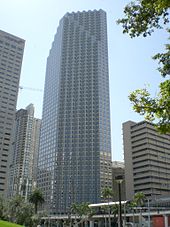 Southeast Financial Center, the tallest skyscraper built in the 1980s office boom
Southeast Financial Center, the tallest skyscraper built in the 1980s office boom
In the 1980s, Miami became one of the United States' largest transshipment point for cocaine from Colombia, Bolivia, and Peru.[29] The drug industry brought billions of dollars into Miami, which were quickly funneled through front organizations into the local economy. Luxury car dealerships, five-star hotels, condominium developments, swanky nightclubs, major commercial developments and other signs of prosperity began rising all over the city. As the money arrived, so did a violent crime wave that lasted through the early 1990s. The popular television program Miami Vice, which dealt with counter-narcotics agents in an idyllic upper-class rendition of Miami, spread the city's image as one of America's most glamorous subtropical paradises.
During the 1980s and early 1990s, many noted people visited Miami. Pope John Paul II visited in November 1987, and held an open-air mass for 150,000 people in Tamiami Park.[30] Queen Elizabeth II and three United States presidents also visited Miami. Among them was Ronald Reagan, who had a street named after him in Little Havana.[31] Nelson Mandela's 1989 visit to the city was marked by ethnic tensions. Mandela had praised Cuban leader Fidel Castro for his anti-apartheid support on ABC News' Nightline. Because of this, the city withdrew its official greeting and no high-ranking official welcomed him. That led to a boycott by the local African American community of all Miami tourist and convention facilities until Mandela received an official greeting. However, all efforts to resolve it failed for months, resulting in an estimated loss of over $10 million.[32]
1990s
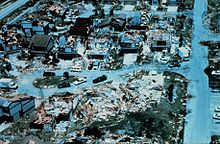 The aftermath of Hurricane Andrew in the Miami area.
The aftermath of Hurricane Andrew in the Miami area.
Hurricane Andrew caused more than $20 billion in damage just south of the Miami-Dade area in 1992.[33]
Several financial scandals involving the Mayor's office and City Commission during the 1980s and 1990s left Miami with the title of the United States' 4th poorest city by 1996. With a budget shortfall of $68 Million and its municipal bonds given a junk bond rating by Wall Street, Miami became Florida's first city to have a state appointed oversight board assigned to it in 1997. In the same year, city voters rejected a resolution to dissolve the city and make it one entity with Dade County. The City's financial problems continued until political outsider Manny Diaz was elected Mayor of Miami in 2001.
Twenty-first century
2000s: A new era
 In recent years[when?], Miami has promoted the arts, business and the performing arts, such as the Adrienne Arsht Center for the Performing Arts, the second-largest performing arts center in the U.S. Other projects include the new Miami Marlins Stadium, Miami Streetcar, Port of Miami Tunnel and Museum Park which includes the Miami Art Museum and the Miami Science Museum.
In recent years[when?], Miami has promoted the arts, business and the performing arts, such as the Adrienne Arsht Center for the Performing Arts, the second-largest performing arts center in the U.S. Other projects include the new Miami Marlins Stadium, Miami Streetcar, Port of Miami Tunnel and Museum Park which includes the Miami Art Museum and the Miami Science Museum.
The Elián González uproar was a heated custody and immigration battle in the Miami area in 2000. The controversy concerned six-year-old Elián González, who was rescued from the waters off the coast of Miami. The U.S. and the Cuban governments, his father Juan Miguel González, his Miami relatives, and the Cuban-American community of Miami were involved. The climactic stage of this prolonged battle was the April 22, 2000, seizure of Elián by federal agents, which drew the criticism of many in the Cuban-American community. During the controversy, Alex Penelas, the mayor of Miami-Dade County at the time, vowed that he would do nothing to assist the Bill Clinton administration and federal authorities in their bid to return the six-year-old boy to Cuba. Tens of thousands of protesters, many of whom were outraged at the raid, poured out into the streets of Little Havana and demonstrated. Car horns blared, demonstrators turned over signs, trash cans, and newspaper racks and some small fires were started. Rioters jammed a 10-block area of Little Havana. Shortly afterwards, many Miami businesses closed, as their owners and managers participated in a short, one-day boycott against the city, attempting to affect its tourism industry. Employees of airlines, cruise lines, hotels, car rental companies, and major retailers participated in the boycott. Elián González returned to Cuba with his father on June 28, 2000.
The controversial Free Trade Area of the Americas negotiations occurred in 2003. It was a proposed agreement to reduce trade barriers while increasing intellectual property rights. During the 2003 meeting in Miami, the Free Trade Area of the Americas was met by heavy opposition from anti-corporatization and anti-globalization protests.
On June 27, 2005, the popular ex-city commissioner Arthur Teele walked into the main lobby of the Miami Herald headquarters, dropped off a package for columnist Jim DeFede, and told the security guard to tell his wife Stephanie he "loved her" before pulling out a gun and committing suicide. His suicide happened the day the alternative weekly Miami New Times published salacious details of Teele's alleged affairs, including allegations that Teele had sex with a transsexual prostitute and used cocaine.[34] At the time, Teele was being investigated by federal authorities for fraud and money laundering for allegedly taking $59,000 in kickbacks to help a businessman get millions of dollars in contracts at Miami International Airport.[35] Teele was suspended from his job in 2004 by Florida governor Jeb Bush after being arrested for trying to run a police officer off the road. Teele was also charged in December 2004 with ten counts of unlawful compensation on charges he took $135,000 from TLMC Inc., promising that it would be awarded lucrative contracts to redevelop neighborhoods in Miami. Teele was also found guilty in March 2005 for threatening an undercover detective.[36]
In the latter half of the 2000-2010 decade, Miami has seen an extensive boom of high rise architecture, dubbed a "Miami Manhattanization" wave. This has included the construction of many of the tallest buildings in Miami, with nearly 20 of the cities tallest 25 buildings finished after 2005. 2008 and 2007 saw the completion of the largest amount of these buildings. This boom has transformed the look of Downtown Miami, which is now considered to have one of the largest skylines in the United States, ranked behind New York City and Chicago.[A] This boom slowed after the 2008 global financial crisis, with some projects being put on hold and none of the cities tallest buildings being constructed in 2010.
In May 2010, construction began on a major Port of Miami infrastructure project known as the Port of Miami Tunnel, with a total estimated cost of one billion US dollars and an estimated 2014 completion date.
See also
- Downtown Miami Historic District
- History of Florida
- List of mayors of Miami
- Lummus Park Historic District
- National Register of Historic Places listings in Miami, Florida
Notes
- A. ^ New York has 205 existing and under construction buildings over 500 ft (152 m), Chicago has 105, Miami has 36. Source of information: SkyscraperPage.com diagrams: New York City[dead link], Chicago[dead link], Miami[dead link].
References
- ^ Wiggins, Larry. "The Birth of the City of Miami: Incorporation". Historical Museum of Southern Florida. http://www.hmsf.org/collections-south-florida-birth-city.htm#incorporation. Retrieved August 24, 2009.
- ^ George, Paul. "Miami: One Hundred Years of History: The Seminole Wars". Historical Museum of Southern Florida. http://www.hmsf.org/history/south-florida-hundred-years.htm#wars. Retrieved August 24, 2009.
- ^ a b Wiggins, Larry. "The Birth of the City of Miami". Historical Museum of Southern Florida. http://www.hmsf.org/collections-south-florida-birth-city.htm.
- ^ George, Paul S.. "Miami is Born". http://www.hmsf.org/history/south-florida-hundred-years.htm#born. Retrieved August 24, 2009.
- ^ Parks, Arva Moore. Miami: The Magic City. Miami, Fl: Centennial Press, 1991. ISBN 0-9629402-2-4 p 12.
- ^ Wilkinson, Jerry. "Prehistoric Indians.". Retrieved January 29, 2006.
- ^ Parks, p 13
- ^ Parks, p 14
- ^ Parks, p 14-16
- ^ Sturtevant, William C. (1978) The Last of the South Florida Aborigines, in Jerald Milanich and Samuel Proctor, Eds., Tacachale: Essays on the Indians of Florida and Southeastern Georgia during the Historic Period. Gainesville, Florida, The University Presses of Florida.
- ^ Braund, Kathryn E. Holland (1999), Bernard Romans: His Life and Times, in Romans, Bernard (1999). A Concise Natural History of East and West Florida, Modernized reprint of 1775 edition, Tuscaloosa, Alabama and London: The University of Alabama Press. ISBN 0-8173-0876-8. p 6, 56, 354
- ^ Blank, Joan Gill. 1996. Key Biscayne. Sarasota, Florida: Pineapple Press. ISBN 1-56164-096-4. pp. 19, 27.
- ^ History of Miami-Dade county[dead link] retrieved January 26, 2006 Archived January 28, 2006 at the Wayback Machine[dead link]
- ^ Muir, Helen. 1953. Miami, U.S.A. Coconut Grove, Florida: Hurricane House Publishers. Pp. 66-7.
- ^ Dunn, Marvin. Black Miami in the Twentieth Century Gainesville, Fl: University Press of Florida, 1997. ISBN 0-8130-1530-8 p 57-64
- ^ Parks, p 107
- ^ Muir, Helen. Miami, U.S.A. New York: Henry Holt and Company, 1953. p. 160.
- ^ Parks, p 120
- ^ Great Miami Hurricane. Retrieved January 27, 2006.
- ^ Parks, p 131-132
- ^ Miami archives. Retrieved January 21, 2006.
- ^ George, Paul S.. "Miami: One Hundred Years of History: World War II". http://www.hmsf.org/history/south-florida-hundred-years.htm#war. Retrieved August 24, 2009.
- ^ Parks, p 153–155
- ^ "Cubans in Miami, an historical perspective". Cuban-exile.com. http://cuban-exile.com/doc_001-025/doc0016.html. Retrieved 2011-11-06.
- ^ Mizrahi, Adam (7 October 2009). "Cheers to Bacardi – Historic Designation Awarded". Urban City Architecture. http://www.urbancityarch.com/2009/10/historic-designation-bacardi/. Retrieved 17 October 2010.[dead link]
- ^ Miami Herald, December 27, 1979 pg 1B.
- ^ "Reliving the nightmare of the McDuffie riots"[dead link] Miami Herald, dtd September 15, 2002. Retrieved January 28, 2006.
- ^ Dunn, p 256-261
- ^ Awash in a Sea of Money[dead link] Miami-New Times (2005), by Rebecca Wakefield, retrieved August 7, 2006. Archived July 15, 2006 at the Wayback Machine[dead link]
- ^ Miami officials who met Pope John Paul II share world's grief[dead link] (2005), by Ana Rodriguez-Soto, retrieved February 1, 2006. Archived October 15, 2006 at the Wayback Machine[dead link]
- ^ Parks, p 202
- ^ Dunn, p 347
- ^ Hurricane Andrew: South Florida and Louisiana (pdf), by the National Disaster Survey Report. Retrieved February 1, 2006.
- ^ Tales of Teele: Sleaze Stories[dead link] retrieved April 4, 2006 Archived May 19, 2006 at the Wayback Machine[dead link]
- ^ "Arthur Teele Dies After Self-Inflicted Gunshot" NBC 6 News. Retrieved March 1, 2006.
- ^ "With suicide, Teele tried to take control"[dead link] Miami Herald, dated July 30, 2005. Retrieved January 28, 2006.
External links
City of Miami Accent • Arts • Climate • Companies • Downtown • Education • Fire • Government • Historic Landmarks • History • Library • Mayors • Miamians • Music • Neighborhoods • Police • Skyscrapers • Sports • Television • Transportation Categories:
Categories:- History of Miami, Florida
- Histories of cities in Florida
Wikimedia Foundation. 2010.




